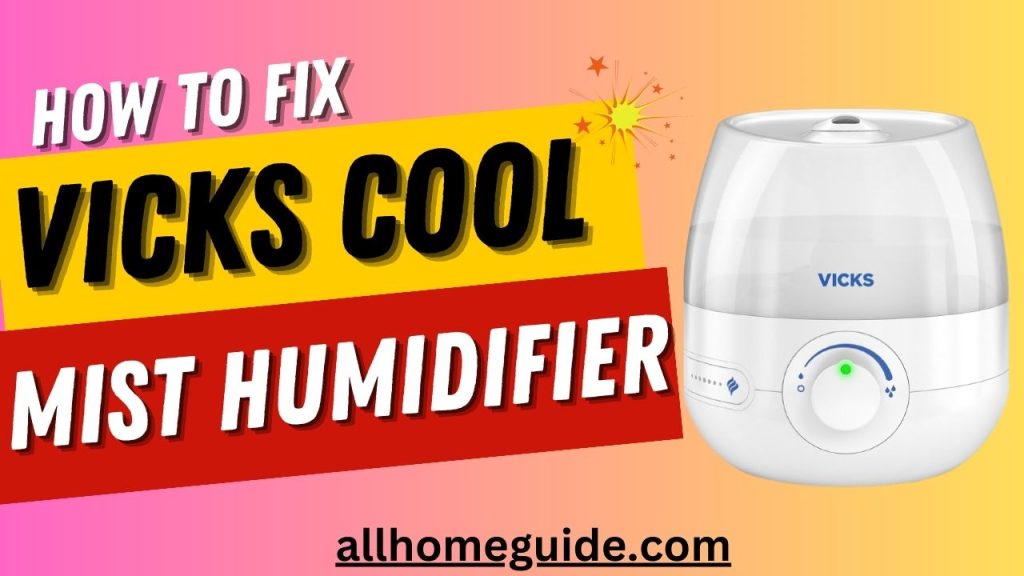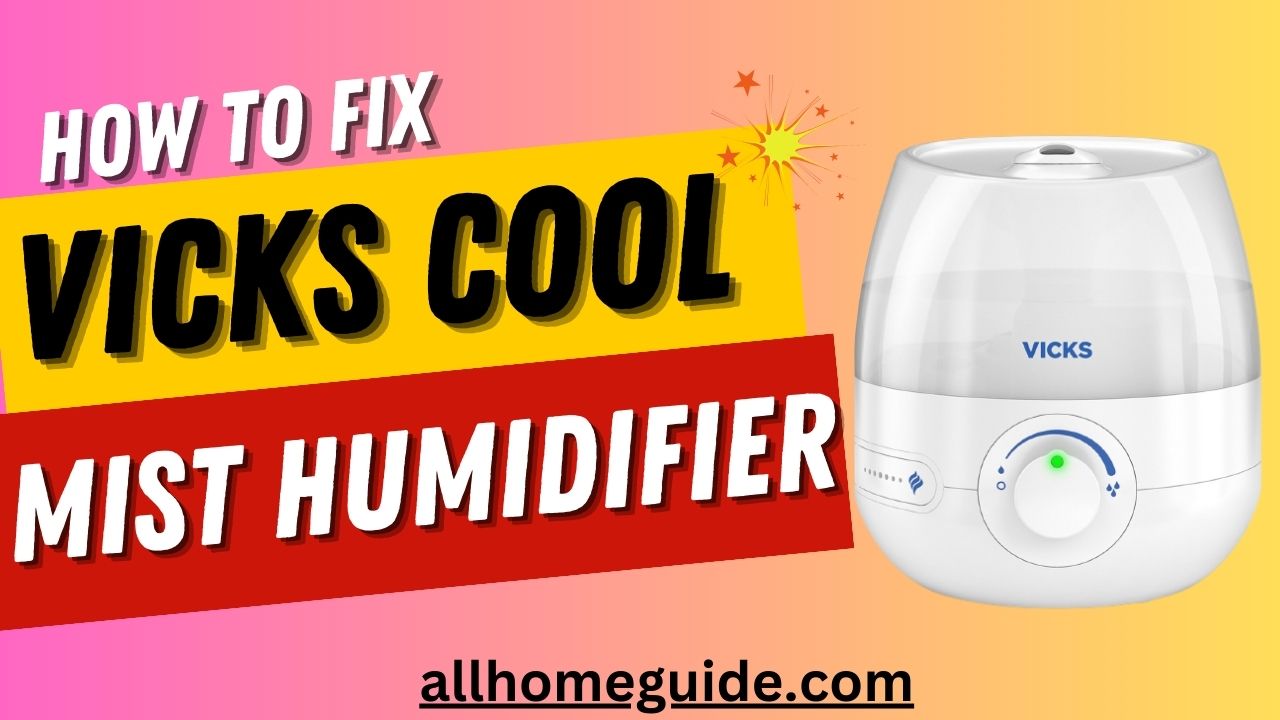When it comes to establishing a comfortable home environment, humidifiers are a godsend, especially in dry winter months or in areas with low humidity. They offer much-needed comfort from scratchy throats, and dry skin, and even lower the risk of a number of health problems brought on by extremely dry air. Vicks Cool Mist Humidifiers have become known for their success in reducing these discomforts among the plethora of humidifiers on the market. However, just like any other appliance, they may experience problems that prevent them from operating properly. If you’re here, there’s a good possibility your Vicks Cool Mist Humidifier has given you some trouble. The good news is that these problems may be resolved quickly and easily that how to fix Vicks cool mist humidifier without the help of a professional.
This in-depth manual intends to lead you through the process of identifying and resolving common issues with your Vicks Cool Mist Humidifier so you may once again take advantage of its many advantages.
We’ll start by talking about some crucial safety measures you should keep in mind when using your humidifier. The troubleshooting method will next be covered, including problems like low mist output, odd noises, leaks, and the machine not turning on. The significance of routine cleaning and maintenance to avoid issues altogether will next be discussed.
By the time you finish reading this manual, you’ll not only be able to identify and resolve the most frequent humidifier issues, but you’ll also know how to keep your humidifier in good working order. So let’s roll up our sleeves and prepare to reintroduce that calming mist into your life.
Safety Precautions
Prioritizing safety is crucial before moving on to troubleshooting and fixing your Vicks Cool Mist Humidifier. Following these safety procedures will protect your safety while performing repairs on electrical and water-related equipment:

1. Unplug the Humidifier:
- Make sure your humidifier is totally turned off and unplugged from the outlet before you start working on it. By doing this, any unintentional electric shocks or short circuits when handling the device would be avoided.
2. Gather Necessary Tools:
- Amass all the tools you’ll require in advance to prevent last-minute delays and frustration throughout the repair process. Depending on what is required, this could also include replacement parts, cleaning brushes, pliers, and screwdrivers.
3. Work in a Well-Ventilated Area:
- You run the risk of coming into contact with dust, mildew, or mold when maintaining or cleaning your humidifier. Make sure the space where you are working has good ventilation, like a room with open windows or doors. If one is obtainable, think about donning one to safeguard your respiratory system.
4. Keep Children and Pets Away:
- Children and animals, who are inherently inquisitive, might want to check out what you’re doing. Keep kids at a safe distance while you work on your humidifier to avoid mishaps. Keep your replacement parts and tools out of their line of sight.
Troubleshooting Your Vicks Cool Mist Humidifier
After discussing safety measures, it’s time to get our hands dirty and start troubleshooting your Vicks Cool Mist Humidifier. Here, we’ll discuss typical problems that could occur and walk you through the methods to identify and resolve them.
1. No Mist or Low Mist Output:
- Check Water Level: Make sure the water tank is correctly filled to the specified amount by checking the water level. Reduced mist production may arise from low water levels.
- Clean the Water Reservoir: Mineral stains and other pollutants can build up in the water reservoir over time, preventing the generation of mist. Rinse the tank well after emptying it and cleaning the reservoir with a vinegar and water solution.
- Inspect the Wick Filter: This essential part is responsible for absorbing water and allowing it to condense into a mist. Check the filter for damage or a buildup of excessive dirt. If it’s unclean, carefully clean it or think about replacing it.
- Check for Proper Assembly: Ensure that all parts, including the water tank, wick filter, and any additional attachments, are put together properly. Occasionally, a loose or poorly fitted component can impair mist output.
2. Strange Noises:
- Check for Blockages: Unplug the humidifier and look for any obstructions like dust, lint, or debris in the fan and mist outlet. Eliminate any obstructions that could be making the noise.
- Clean the Fan Blades: If the noise continues, clean the fan blades since they may be dusty or out of alignment. Use a soft brush or cloth to gently clean the blades, then realign them as needed.
- Tighten Loose Components: Look for any loose screws or other parts on the humidifier. In order to prevent vibrations and strange noises during operation, tighten any loose parts.
3. Leaking Water:
- Check the Water Tank: Make that the water tank is sealed correctly and is free of damage or cracks. If you discover any problems, think about replacing the tank.
- Check Seals and Gaskets: Examine your humidifier’s seals and gaskets for wear and tear because this could cause leaks. Look for evidence of wear or damage on these components, and replace them if necessary.
4. Unit Not Turning On:
- Ensure Power Supply: Verify the power outlet’s functionality and the integrity of the power cord. Additionally, look for any blown fuses or tripped circuit breakers.
- Check the Control Panel: Look for any obvious damage or loosened connections on the control panel. Consider replacing the control panel or the problematic components if you discover any problems.
- Check for a Faulty Motor or Electronics: Look for a bad motor or electronic component: After trying these methods, if the device still won’t switch on, it might have a bad motor or electronic parts. It is best to get in touch with the manufacturer’s customer service or a qualified technician in this situation for additional diagnostic and repair.
Cleaning and Maintenance
To keep your Vicks Cool Mist Humidifier working effectively and to stave off problems in the first place, regular cleaning and maintenance are essential. Here, we’ll offer advice on creating a cleaning schedule, carrying out deep cleaning as necessary, and keeping your humidifier in top condition.
1. Regular Cleaning Routine:
A. Cleaning Frequency:
- When it’s being used frequently or when you observe a drop in mist output, try to clean your humidifier at least once a week. Cleaning before storing and after every usage is advised during times of less frequent use, such as during the summer.
B. Use Distilled Water:
- Use distilled water in your humidifier whenever feasible. It has less minerals and contaminants, which prevents mineral deposits from accumulating inside the appliance.
C. Cleaning Steps:
- Disassemble the humidifier by unplugging it and removing the wick filter, water tank, and other removable parts.
- Remove any remaining water from the tank and foundation.
- Use a solution of white vinegar and water in equal parts to clean the water tank and reservoir. Allow the mineral buildup to dissolve for 30 minutes before giving it a thorough scrub and rinsing.
- Before reassembling, wash the wick filter in cool running water and let it air dry fully.
- With a moist cloth, clean the base’s interior and exterior to get rid of any accumulation or residue.
- Before using, put the humidifier back together and fill the water tank with fresh, distilled water.
2. Deep Cleaning:
Every two weeks or as needed, deep clean your humidifier, especially if it has been in storage for a while. Deep cleaning aids in getting rid of mold or mildew growth as well as difficult mineral deposits.
A. Disassembly:
- Turn off the humidifier’s power source and take off the fan, motor, and any other removable components.
B. Upkeep of the Base:
- For a few hours, submerge the base in a 50/50 solution of white vinegar and water. Mineral deposits will disappear thanks to this.
- Scrub away any leftover residues with a gentle brush or toothbrush.
- Rinse well with fresh water.
C. Wick filter cleaning:
- Consider replacing the wick filter if it is severely contaminated.
- Reusable filters should be soaked in the vinegar and water solution, scrubbed lightly, and thoroughly rinsed before being allowed to air dry.
3. Maintenance Tips:
A. Replace Wick Filters:
- Wick filters should be replaced because of mineral buildup and deterioration over time. They should typically be replaced every one to three months, or as advised by the manufacturer.
B. Keep the Water Tank Clean:
- To stop the growth of mold and mildew, regularly clean the water tank and reservoir. When the tank isn’t in use, empty and dry it.
C. Watch for Mildew and Mold:
- Keep an eye out for any indications of mildew or mold development, especially in obscure nooks and cracks. Clean it right away with a vinegar and water solution if you find any.
Replacing Parts and Components
Your Vicks Cool Mist Humidifier may occasionally experience wear and tear or damage over time, despite your best efforts in maintenance and troubleshooting. It’s crucial to know how to spot and replace these parts if you want to maintain your humidifier operating properly. Here is a guidance on when to replace important parts and components and how to do it:
1. Wick Filter Replacement:
A. Frequency:
- Wick filters should be changed on a regular basis, usually every one to three months, depending on usage and water quality. For further instructions, consult the manufacturer’s guidelines.
B. Steps for Replacement:
- Unplug and shut off the humidifier.
- In accordance with the manufacturer’s instructions, remove the old wick filter.
- Make sure the new wick filter is correctly positioned and aligned before inserting it.
- Reassemble the humidifier and add fresh, distilled water to the water tank.
2. Fan Motor Replacement:
A. Symptoms:
- You might notice that your humidifier isn’t producing any mist or is making strange noises if the fan motor has failed.
B. Replacement Procedures:
- Since replacing the fan motor is a more difficult procedure, it is advised to refer to the manufacturer’s user manual or seek out expert assistance. Usually, it entails:
- To access the fan motor, turn off the power and take the housing off.
- Removing the old fan motor’s screw or clip and cutting its wiring.
- Installing the new fan motor and properly wiring it.
- Putting the housing back together and anchoring it.
3. Control Panel Replacement:
A. Symptoms:
- Your humidifier may have problems turning on or responding to settings if the control panel or electronic components are malfunctioning.
B. Replacement Steps:
The steps involved in replacing the control panel are as follows:
- To access the control panel, turn off the power and open the casing.
- Make a note of the locations of the cables and connectors before carefully removing them from the previous control panel.
- Install the new control panel and reroute the cables as necessary.
- Make sure everything is firmly in place before putting the housing back together.
4. Water Tank and Reservoir Replacement:
A. Symptoms:
- It may be required to replace your humidifier’s water tank or reservoir if it develops cracks, is difficult to clean, or is otherwise damaged.
B. Steps for Replacement:
- Purchase a replacement water tank or reservoir from the maker or a licensed dealer.
- To remove the old tank or reservoir, follow the manufacturer’s instructions.
- Install the new tank or reservoir, making that the connection and seal are secure.
- Reassemble the humidifier, put clean, purified water in the tank, and check how it works.
5. Where to Find Replacement Parts:
Consider these choices while looking for Vicks Cool Mist Humidifier replacement parts and components:
A. Website of the Manufacturer:
- For information on where to buy genuine replacement parts, visit the manufacturer’s official website or get in touch with their customer care.
B. Authorized Dealers and Retailers:
- A few authorized dealers or retailers may have spare parts on hand for the humidifier model you’re using.
C. Online marketplaces:
- There is frequently a large range of replacement parts for different humidifier types on websites like Amazon, eBay, or specialty appliance parts merchants.
D. Local Appliance Repair Shops:
- You might be able to find and replace parts for your appliance through local repair shops or appliance service centers.
Also read: how to reset crane humidifier
Conclusion
Even while many difficulties can be fixed by doing it yourself, it’s best to contact the manufacturer’s customer service or hire a professional if you run into complicated issues or problems that are outside the scope of your knowledge. In the end, by maintaining your humidifier, you may breathe easier and take advantage of the comfort it offers for many years to come.


1 thought on “How To Fix Vicks Cool Mist Humidifier- A Comprehensive Guide”